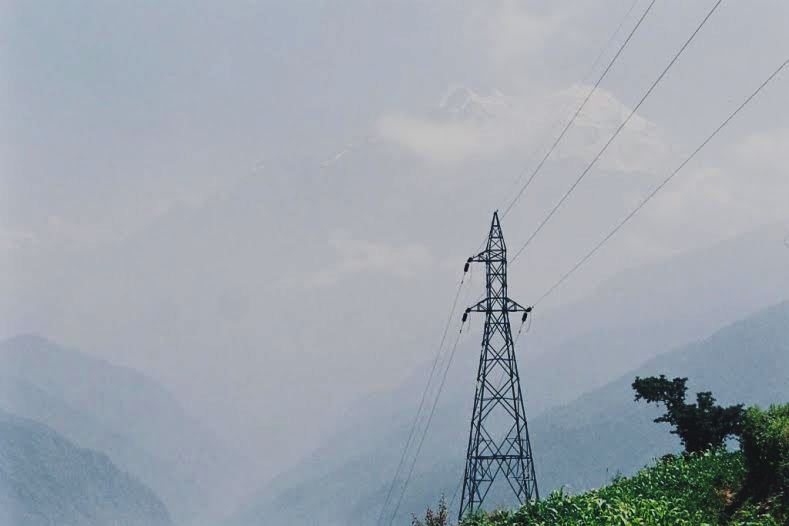Govt’s 2016 energy document can’t be solely credited for reduction in load-shedding
Injina Panthi / April 27, 2018

A transmission line in Rasuwa.
Former Managing Director of Nepal Electricity Authority Mukesh Kafle in an interview aired on Sagarmatha TV on April 16, 2018 said the following:
“The National Energy Crisis Prevention and Electricity Development Decade Document 2016 was prepared after much hard work. Everything that has been happening in the power sector now is based on that document. The document has stated that load-shedding will end from the year 2073 [mid-April 2016].”
South Asia Check has examined Kafle’s statement.
Schedule 3 of the 2016 document, which Kafle also produced during the interview, states: “To end load-shedding within a year, the following measures will be taken: In the next one year, the peak demand during the dry season is expected to reach 1423 megawatts. And, the possible sources for power during the dry season are as follows:
| One-third of the current total installed capacity of 684 MW | 228 MW |
| One third of the 200 MW of private sector hydropower projects to be connected to the national grid within one year. | 67 MW |
| Electricity from reservoir-based Kulekhani I and Kulekhani II | 92 MW |
| Import from India
|
580 MW |
| Energy from solar and wind power
|
100 MW |
| Total | 1067MW |
Note: The shortfall will be arranged from other renewable energy sources.”
Kathmandu Valley had seen a sharp fall in load-shedding hours from November 2015. But most of the measures recommended in the document were not implemented when the government moved to reduce load-shedding.
The measures the government had taken to reduce load-shedding included:
Power generated by the private sector was added to the national grid: As the then NEA spokesperson told to South Asia check then (for details please click here) “the contribution of independent power producers to the national grid was 325 MW until the end of fiscal year 2014/15. Since the beginning of the new fiscal year [2015/16], that amount has risen to 450 MW with 105 MW added in the last nine months.”
Import from India: Nepal had imported 345 MW from India in the fiscal year 2014/2015. In fiscal year 2015/2016 Nepal imported an additional 40-42 MW from India. When the program to end load-shedding was implemented, total import from India had reached 387 MW which was less than the document predicted.
Leakage control: When the NEA reduced load-shedding for households, NEA had cut down leakage by around 4 percent over a period of 6-7 months and this saved 50 MW.
The National Energy Crisis Prevention and Electricity Development Decade Document 2016 said that 100 MW would be generated from solar and wind power. But no progress has been made toward this end so far. However, earlier this month, a solar power plant of around 1 megawatt capacity came into operation at Singha Durbar.
Therefore Kafle’s claim that the load-shedding came down as per the National Energy Crisis Prevention and Electricity Development Decade Document 2016 is wrong.
This material is copyrighted but may be used for any purpose by giving due credit to southasiacheck.org.
Comments
Latest Stories
- In Public Interest Covid-19 cases are low, but that’s not an excuse to avoid vaccination
- In Public Interest What is BF.7, the sub-variant that has the world by its grip?
- In Public Interest Threat of a new Covid-19 wave looms large amid vaccine shortage in Nepal
- In Public Interest As cases decline, Covid-19 test centres in Kathmandu are desolate lot
- In Public Interest Dengue test fee disparity has patients wondering if they’re being cheated
- In Public Interest As dengue rages on, confusion galore about what it is and what its symptoms are. Here’s what you need to know
In Public Interest
 Covid-19 cases are low, but that’s not an excuse to avoid vaccination
The Pfizer-BioNTech bivalent vaccines authorised by the Nepal Government provide better protection a...
Read More
Covid-19 cases are low, but that’s not an excuse to avoid vaccination
The Pfizer-BioNTech bivalent vaccines authorised by the Nepal Government provide better protection a...
Read More
- What is BF.7, the sub-variant that has the world by its grip?
- Threat of a new Covid-19 wave looms large amid vaccine shortage in Nepal
- As cases decline, Covid-19 test centres in Kathmandu are desolate lot
- Dengue test fee disparity has patients wondering if they’re being cheated
- As dengue rages on, confusion galore about what it is and what its symptoms are. Here’s what you need to know